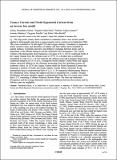Por favor, use este identificador para citar o enlazar a este item:
http://hdl.handle.net/10261/318563COMPARTIR / EXPORTAR:
 SHARE SHARE
 CORE
BASE CORE
BASE
|
|
| Visualizar otros formatos: MARC | Dublin Core | RDF | ORE | MODS | METS | DIDL | DATACITE | |

| Título: | Canary Current and North Equatorial Current from an Inverse Box Model |
Autor: | Hernández-Guerra, Alonso; Fraile-Nuez, Eugenio; López-Laatzen, Federico; Martínez, A.; Parrilla-Barrera, Gregorio; Vélez-Belchí, Pedro CSIC ORCID | Palabras clave: | Centro Oceanográfico de Canarias Medio Marino |
Fecha de publicación: | 2005 | Citación: | Journal of Geophysical Research-Oceans, 110. 2005: - | Resumen: | The large-scale Canary Basin circulation is estimated from a box inverse model applied to hydrographic data from a quasi-synoptic survey carried out in September 2003. The cruise consisted of 76 full depth CTD and oxygen stations. Circulation is required to nearly conserve mass and anomalies of salinity and heat within layers bounded by neutral surfaces. It permits advective and diffusive exchange between layers and an adjustment of the Ekman transport and the freshwater flux divergences. The Canary Current at the thermocline layer transports a net mass of 4.7 ± 0.8 Sv southward north of the Canary Islands from the African coast to 19°W. It is divided into a northward circulation at a rate of 1.1 ± 0.5 Sv between the African coast and Lanzarote Island and a southward transport of 5.8 ± 0.6 Sv. It transports North Atlantic Central Water and organic matters advected offshore by the filaments protruding from the upwelling system off northwest Africa. At 24°N, the Canary Current feeds the North Equatorial Current that transports a mixture of North and South Atlantic Central Waters westward. In the intermediate layer a southwestward flow of 1.2 ± 1.1 Sv transports Mediterranean Water to the Subtropical Gyre, though the highest salt flux is transported by a meddy. Oxygen distribution and mass transport suggest a northeastward deep flow of a water mass colder than 2.2°C consisting of diluted Antarctic Bottom Water. The heat and freshwater divergences and the average dianeutral velocity and diffusion between the sections and the African coast are negligible. | Versión del editor: | https://agupubs.onlinelibrary.wiley.com/doi/full/10.1029/2005JC003032 | URI: | http://hdl.handle.net/10261/318563 | DOI: | 10.1029/2005JC003032 | ISSN: | 2169-9291 |
| Aparece en las colecciones: | (IEO) Artículos |
Ficheros en este ítem:
| Fichero | Descripción | Tamaño | Formato | |
|---|---|---|---|---|
| 2005_Hernandez-Guerra_etal.pdf | 1,32 MB | Adobe PDF |  Visualizar/Abrir |
CORE Recommender
SCOPUSTM
Citations
56
checked on 15-may-2024
WEB OF SCIENCETM
Citations
49
checked on 26-feb-2024
Page view(s)
28
checked on 20-may-2024
Download(s)
18
checked on 20-may-2024
Google ScholarTM
Check
Altmetric
Altmetric
Este item está licenciado bajo una Licencia Creative Commons

